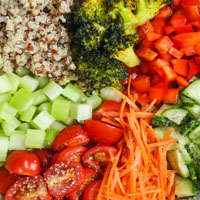Municipal organic waste compost replaces mineral fertilization in the horticultural cropping systems, reducing the pollution risk

Accepted: 3 March 2021
PDF: 564
All claims expressed in this article are solely those of the authors and do not necessarily represent those of their affiliated organizations, or those of the publisher, the editors and the reviewers. Any product that may be evaluated in this article or claim that may be made by its manufacturer is not guaranteed or endorsed by the publisher.
Municipal waste compost was evaluated under open field conditions for replacing synthetic fertilizers in a vegetable three-year succession. Three compost rates, 45 t ha–1, 30 t ha–1 and 15 t ha–1 (dry matter), and compost at 15 t ha–1 combined with 25%, and 50% of the full synthetic nitrogen rate, were compared to full and none synthetic nitrogen fertilizations. Crop succession was: tomato followed by endive in the first year; eggplant and, then, broccoli in the second year; tomato and, then, endive/broccoli, in the third year. The application of compost at a dose of at least 30 t ha–1 or at 15 t ha–1 with the addition of 25% of the full synthetic nitrogen rate, in Spring-Summer cycle, sustained growth and yield at levels comparable with those of synthetic nitrogen fertilization. However, only a very poor residual effect of the compost soil treatment on the yield of Autumn-Winter crops, was observed. Monitoring of nitrate content into the soil during cropping seasons, a reduction of the risk of groundwater pollution was displayed due to nitrates released by compost, respect to synthetic nitrogen fertilizer. The cumulative effects of compost application on soil properties were detected at the end of the field trials, registering changes in chemical parameters analysed, except for phosphorus and boron.
Highlights
- Municipal solid organic waste compost (MSWC) integrated with N fertilizers can sustain vegetable production.
- MSWC (at least 30 t ha–1 d.w.) replaced synthetic fertilizers for tomato and eggplant productions.
- N fertilizer integration to the compost residual effect is necessary to sustain endive and broccoli productions.
- MSWC (at 15 t ha–1 d.w.) needs 25% of N integration to reduce the gap with plant only fertilized with N fertilizer.
- MSWC preserved soil quality and avoided accumulation of undesired metals, such as Cu and Zn.
How to Cite

This work is licensed under a Creative Commons Attribution-NonCommercial 4.0 International License.
PAGEPress has chosen to apply the Creative Commons Attribution NonCommercial 4.0 International License (CC BY-NC 4.0) to all manuscripts to be published.

 https://doi.org/10.4081/ija.2021.1756
https://doi.org/10.4081/ija.2021.1756







